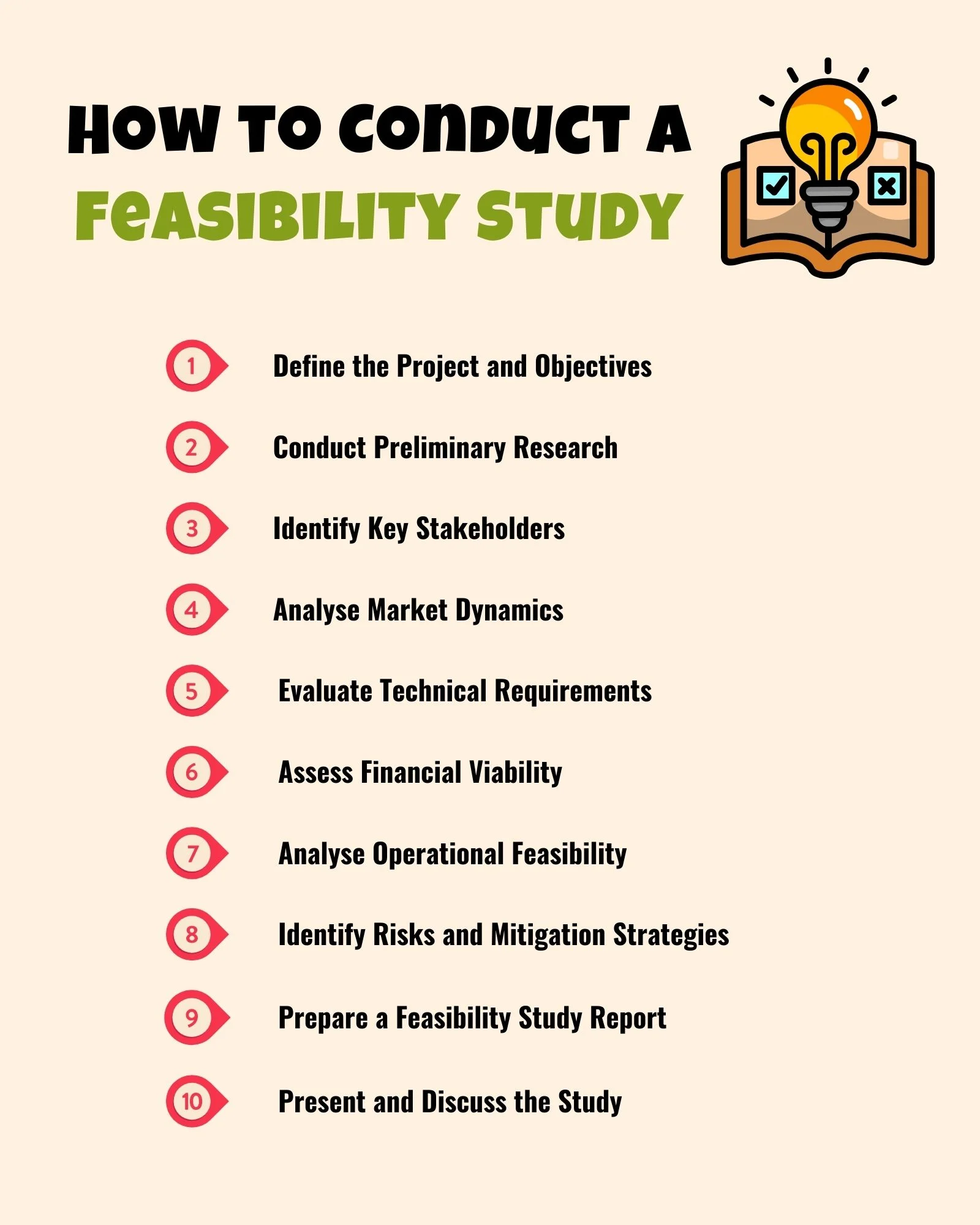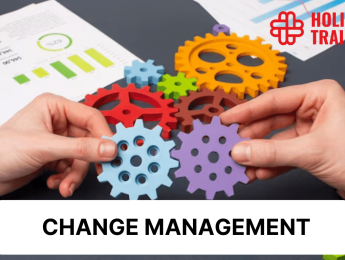- Table of Contents
- Introduction
- What Is a Feasibility Study?
- Who Is Responsible for Conducting a Feasibility Study?
- The Importance of a Feasibility Study
- Risk Mitigation
- Market Insights
- Strategic Decision-Making
- Financial Planning
- Resource Allocation
- Stakeholder Alignment
- Avoiding Costly Mistakes
- Regulatory Compliance
- Improved Communication
- Types of Feasibility Study
- Market Feasibility Study
- Technical Feasibility Study
- Financial Feasibility Study
- Operational Feasibility Study
- How to Conduct a Feasibility Study
- Step 1: Define the Project and Objectives
- Step 2: Conduct Preliminary Research
- Step 3: Identify Key Stakeholders
- Step 4: Analyse Market Dynamics
- Step 5: Evaluate Technical Requirements
- Step 6: Assess Financial Viability
- Step 7: Analyse Operational Feasibility
- Step 8: Identify Risks and Mitigation Strategies
- Step 9: Prepare a Feasibility Study Report
- Step 10: Present and Discuss the Study
- Your Role in Performing Feasibility Analysis As a Project Manager
- Project Initiation
- Team Selection
- Risk Assessment and Mitigation
- Resource Allocation
- Project Planning and Execution
- Communication and Reporting
- Decision Support
- Conclusion
Introduction
In the fast-paced business world, strategic decision-making is the linchpin of success. When embarking on a new venture, understanding its feasibility becomes paramount. This is where the feasibility study comes into play—a robust tool that evaluates a project's potential success and provides indispensable insights. This extensive guide will delve into the art of conducting a feasibility study, arming you with the knowledge to make well-informed choices and successfully navigate the path to triumph.
What Is a Feasibility Study?
At its core, a feasibility study is a meticulous analysis that assesses the practicality and viability of a proposed project. Its primary objective is to determine whether the project is achievable, economically sound, and aligned with the organisation's goals and objectives. By examining various facets such as market potential, technical prerequisites, financial considerations, and operational feasibility, a feasibility study provides decision-makers with a comprehensive understanding of the project's prospects.
Who Is Responsible for Conducting a Feasibility Study?
Conducting a feasibility study necessitates a multidisciplinary approach. Typically, the responsibility falls upon a team comprising professionals with expertise in diverse domains, including project management, finance, marketing, operations, and technical aspects. This diverse team should clearly understand the project's objectives and possess the analytical skills required to collect, analyse, and interpret data effectively. Furthermore, involving stakeholders and subject matter experts in the process ensures a comprehensive and well-rounded study.
Role | Responsibilities |
Project Manager | Lead study coordination and risk assessment |
Finance Expert | Analyse financial viability and ROI |
Marketing Specialist | Assess market potential and competition |
Technical Advisor | Evaluate technical requirements and constraints |
Operation Analyst | Examine operational compatibility and impacts |
Stakeholder Involvement | Engage stakeholders and gather input |
Sugject Matter Experts | Provide specialised knowledge and insight |
Table 1: People who play a role in conducting a feasibility study and their different responsibilities
The Importance of a Feasibility Study
A feasibility study serves as the linchpin of informed decision-making in the world of business, and its significance cannot be overstated. Let's dive into why conducting a feasibility study is crucial:
Risk Mitigation
One of the primary benefits of a feasibility study is its ability to identify potential risks and challenges associated with a project. These risks could be related to market volatility, technical complexities, financial constraints, or operational hurdles. Organisations can develop effective mitigation strategies by proactively identifying and assessing these risks. This risk mitigation safeguards the project and enhances the organisation's ability to adapt to unexpected challenges.
Market Insights
Understanding market dynamics is paramount in today's dynamic business landscape. A feasibility study delves deep into the market, providing insights into consumer preferences, market trends, and competitive forces. It helps organisations gauge market demand for their product or service and provides a clear picture of the target audience. With this knowledge, businesses can tailor their strategies to meet customer needs and gain a competitive edge effectively.
Strategic Decision-Making
Strategic decisions are the cornerstone of an organisation's success. A feasibility study equips decision-makers with the data and insights needed to make strategic choices. It is a compass, guiding organisations towards projects that align with their long-term goals and objectives. By evaluating the feasibility of various options, organisations can prioritise projects with the highest potential for success and return on investment.
Financial Planning
The financial aspect of any project is a critical factor. A feasibility study provides a comprehensive financial analysis, including projected costs, revenue streams, return on investment (ROI), and payback period. This financial evaluation enables organisations to make informed budgeting, resource allocation, and financial planning decisions. It ensures that resources are allocated efficiently and that projects are financially sustainable in the long run.
Resource Allocation
Effective resource allocation is essential for the successful execution of a project. A feasibility study helps organisations determine the resources required, both in terms of personnel and capital. This information is invaluable for budgeting and resource allocation, ensuring that the necessary assets and expertise are available when needed. Efficient resource allocation minimises waste and optimises project execution.
Stakeholder Alignment
Involving stakeholders in the feasibility study process fosters alignment and collaboration. When stakeholders understand the rationale behind a project and its potential benefits, they are more likely to support it. Furthermore, their input during the study can lead to valuable insights and adjustments that enhance the project's chances of success. A well-informed and supportive stakeholder base is a valuable asset in project implementation.
Avoiding Costly Mistakes
Proceeding with a project without a thorough feasibility study is akin to navigating in the dark. It increases the risk of making costly mistakes that could have been avoided with proper analysis. Feasibility studies act as a safety net, preventing organisations from investing time, money, and resources in ventures with a low probability of success. By uncovering potential pitfalls early on, organisations can make course corrections or opt not to proceed, saving significant resources in the long run.
Regulatory Compliance
Many industries are subject to complex regulatory frameworks. A feasibility study includes assessing the legal and regulatory aspects that may impact the project. This ensures the organisation is aware of and compliant with all relevant laws and regulations. Failing to consider regulatory requirements can lead to costly delays, fines, or even project cancellations.
Improved Communication
Conducting a feasibility study encourages open communication among team members, stakeholders, and decision-makers. It fosters transparency and ensures everyone understands the project's goals, challenges, and potential outcomes. This improved communication leads to more effective collaboration and decision-making throughout the project's lifecycle.
In summary, a well-executed feasibility study is not just a preliminary step; it's a cornerstone of sound business practice. It empowers organisations to make informed decisions, mitigate risks, allocate resources efficiently, and align projects with strategic goals. By investing time and effort into conducting comprehensive feasibility studies, businesses set themselves on a path to increased success and sustainability in an ever-evolving business landscape.
Types of Feasibility Study
Feasibility studies can be classified into several types, each serving a specific purpose. Let's delve deeper into the most common types of feasibility studies:
Market Feasibility Study
A market feasibility study serves as a compass for understanding the potential success of a project within its target market. Beyond merely evaluating market size and demand, it dives into consumer preferences, demographic trends, and psychographics. This comprehensive analysis helps organisations grasp the size of their potential customer base and their purchasing behaviour and preferences. Additionally, a market feasibility study explores the competitive landscape, identifying key competitors, their strengths and weaknesses, and the barriers to entry into the market. By delving into these aspects, organisations can make more informed decisions about market entry strategies, pricing models, and product positioning.
Technical Feasibility Study
The technical feasibility study is a linchpin for projects that rely heavily on technology. It delves into the intricacies of the technology required, examining its availability, scalability, and compatibility with existing infrastructure. Beyond assessing the mere presence of technology, it evaluates the expertise needed to implement and maintain the technology effectively. This type of feasibility study also identifies potential technical constraints and challenges, such as resource scarcity or the need for specialised training. In today's rapidly evolving technological landscape, a comprehensive technical feasibility study is essential to ensure that a project can harness the necessary tools and infrastructure for success.
Financial Feasibility Study
Financial viability is at the heart of every project. A financial feasibility study is not merely a financial forecast; it's a strategic financial roadmap. In addition to projecting costs and revenues, it examines the intricacies of financing, including potential funding sources, investment requirements, and capital structure. This study also scrutinises the financial metrics that matter most, such as net present value (NPV), internal rate of return (IRR), and break-even analysis. By delving into these metrics, organisations can gauge the project's financial attractiveness and its alignment with long-term financial goals. Moreover, it helps devise risk mitigation strategies if financial projections do not materialise as expected.
Operational Feasibility Study
A successful project is not just about the end result but also about how seamlessly it integrates into existing operations. An operational feasibility study goes beyond technical considerations to assess how a project will impact an organisation's day-to-day processes, resources, and workforce. It examines process reengineering, workforce training, and system integration. Furthermore, this study evaluates the potential disruption to ongoing operations and outlines strategies to minimise such disruptions. Operational feasibility is particularly vital in industries where smooth, uninterrupted operations are paramount, such as manufacturing or healthcare. By understanding the operational implications of a project, organisations can plan for a more seamless transition and reduce the risk of operational bottlenecks.
Type of Feasibility Study | Focus | Key Considerations |
Market Feasibility Study | Demand, market size, target audience, competition, trends | Consumer preferences, market growth prospects |
Technical Feasibility Study | Technological requirements, resource availability, expertise | Infrastructure needs, potential roadblocks |
Financial Feasibility Study | Projected costs, revenue streams, ROI, payback period | Financial attractiveness, alignment with goals |
Operational Feasibility Study | Compatibility with existing systems, processes, and resources | Integration with ongoing operations, minimal disruption |
Table 1: Types of feasibility study
How to Conduct a Feasibility Study
Now that we have established a firm understanding of the definition, importance, and types of feasibility studies, let's delve into the step-by-step process of conducting a comprehensive feasibility study:

Step 1: Define the Project and Objectives
Defining the project and its objectives is not a mere formality but a crucial foundation for the entire study. Articulating the scope, goals, and expected outcomes helps set the study's boundaries. Moreover, it ensures alignment among stakeholders, preventing potential misunderstandings or deviations from the project's original intent. This step involves identifying the project's tangible and intangible aspects, as it's essential to account for all variables that could affect its feasibility.
Step 2: Conduct Preliminary Research
The preliminary research phase is akin to laying the groundwork for a solid structure. Relevant data, industry reports, market research, and expert opinions form the basis for the subsequent analysis. Beyond collecting data, this phase involves critically reviewing and synthesising information to identify gaps and potential areas of concern. The goal is to gain a holistic view of the project's context and challenges, making the feasibility study more focused and insightful.
Step 3: Identify Key Stakeholders
Engaging key stakeholders at this stage is a courtesy and a strategic imperative. Their input provides invaluable perspectives, expectations, and concerns that can shape the study's direction. Establishing a channel for ongoing communication with stakeholders throughout the study is essential, as their insights may evolve as the analysis progresses. This collaborative approach ensures that the study benefits from diverse viewpoints and remains aligned with the organisation's overarching objectives.
Step 4: Analyse Market Dynamics
A market feasibility study involves a deep dive into the market landscape. Beyond assessing market size and growth potential, it's essential to understand the nuances of consumer behaviour. This analysis could involve surveys, focus groups, or data analytics to uncover hidden trends and preferences. Additionally, evaluating the competitive landscape should not be limited to identifying competitors; it should also involve an assessment of their strengths and weaknesses. This holistic understanding of market dynamics allows for more accurate market entry strategies and targeted marketing efforts.
Step 5: Evaluate Technical Requirements
In the world of rapidly evolving technology, assessing technical feasibility is more than just ticking boxes. It requires an in-depth examination of the technological prerequisites. Evaluating the availability of resources, including both hardware and software, is critical. Additionally, the study should explore the scalability of the chosen technology to accommodate potential growth. Identifying potential bottlenecks or constraints, such as a shortage of skilled personnel or infrastructure limitations, is essential. This detailed evaluation ensures that the project can harness the necessary technology effectively and adapt to emerging trends.
Step 6: Assess Financial Viability
The financial feasibility study is not merely a financial forecast; it's a strategic financial plan. In addition to projecting costs and revenues, it should consider various financial scenarios and risk factors. Sensitivity analysis, for instance, can help understand how changes in key variables might impact the project's financial performance. Furthermore, this step should explore potential funding sources and financing options, weighing the pros and cons of each. By examining the project's financial viability from multiple angles, organisations can make more informed decisions about investment, funding, and financial risk management.
Step 7: Analyse Operational Feasibility
Operational feasibility is more than just a checklist of tasks; it's a comprehensive evaluation of how the project integrates with existing operations. Beyond identifying potential operational challenges, it should include a robust plan for transitioning from the project's implementation phase to normal operations. This might involve process reengineering, workforce training, or adjustments to existing systems. The goal is to ensure the project can seamlessly incorporate into the organisation's day-to-day activities with minimal disruption.
Step 8: Identify Risks and Mitigation Strategies
Risk identification is a proactive measure to safeguard the project's success. Beyond listing potential risks, the study should assess their likelihood and potential impact. A risk matrix, for instance, can help prioritise risks based on their severity and likelihood. Importantly, the study should not stop at risk identification but should also outline concrete mitigation strategies for each identified risk. This proactive approach ensures the project is prepared to handle unforeseen challenges and reduces the likelihood of costly surprises during implementation.
Step 9: Prepare a Feasibility Study Report
The final feasibility study report should be more than a compilation of findings; it should be a compelling document that tells a coherent story. It should briefly summarise the study's objectives, methodology, findings, and recommendations. Furthermore, it should provide context for the findings, explaining how each piece of data fits into the larger picture. Visual aids such as charts and graphs can enhance the report's clarity and accessibility. Lastly, the report should acknowledge any potential limitations or uncertainties in the study's findings, ensuring that decision-makers have a realistic understanding of the project's feasibility.
Step 10: Present and Discuss the Study
The presentation of the feasibility study is a crucial step in the process. It's not just about delivering information; it's about engaging stakeholders and decision-makers in a meaningful discussion. The presentation should facilitate an open dialogue where questions can be addressed and insights shared. Moreover, it should emphasise the implications of the study's findings regarding opportunities and challenges. Effective communication during this phase is essential for gaining consensus and ensuring all stakeholders understand the study's outcomes clearly.
Your Role in Performing Feasibility Analysis As a Project Manager
As a project manager, you play a pivotal role in performing feasibility analysis. Your expertise in project management methodologies and your ability to assess risks and opportunities are instrumental in conducting a comprehensive feasibility study. It's worth noting that a feasibility study typically takes place after the project proposal has been presented but before any actual implementation begins. It serves as an integral component of the project planning process, often conducted in parallel with other assessments like a SWOT analysis or project risk assessment, according to Asana. Now, let’s delve into the key aspects of your role in the process:
Project Initiation
As a project manager, you are actively involved in the project initiation phase. You collaborate closely with stakeholders to define the project's scope, objectives, and expected outcomes. Your role is to ensure clear communication and alignment among team members and stakeholders regarding the feasibility study's purpose and goals.
Team Selection
Your responsibility includes assembling a capable and multidisciplinary team to conduct the feasibility study. This team should encompass professionals with expertise in areas such as finance, marketing, operations, and technical aspects. As the project manager, you oversee the team's collaboration and ensure a comprehensive approach to the analysis.
Risk Assessment and Mitigation
Your role extends to identifying potential risks and challenges associated with the project. Through your experience and knowledge, you can facilitate risk assessments and assist the team in developing effective mitigation strategies. By proactively addressing and managing risks, you contribute to the project's success and minimise potential roadblocks.
Resource Allocation
As a project manager, you are responsible for overseeing the allocation of resources for the feasibility study. This includes managing the budget, assigning personnel, and coordinating with various stakeholders to ensure the availability of necessary resources. Effective resource allocation is vital to thorough analysis and accurate results.
Project Planning and Execution
You play a pivotal role in developing the feasibility study's project plan. This involves defining the study's timeline, milestones, and deliverables. Throughout the study, you monitor progress, track milestones, and ensure the analysis is conducted per the defined plan. Your project management skills are instrumental in keeping the study on track and within the allocated resources.
Communication and Reporting
As the project manager, you facilitate effective communication among team members, stakeholders, and decision-makers. You prepare regular progress reports highlighting key findings, insights, and recommendations. Clear and concise communication ensures that decision-makers comprehensively understand the feasibility study's outcomes.
Decision Support
Your role extends beyond conducting the study itself. As a project manager, you provide decision support to stakeholders and decision-makers. You help interpret the study's results, present implications, and contribute to the decision-making process. Your expertise in project management and your understanding of the project's objectives make you a valuable asset in making informed choices.
By embracing your role in performing feasibility analysis, you enhance the overall effectiveness of the study and contribute to the project's success. Your project management skills, risk management expertise, and communication ability are vital in the feasibility study process. Embrace this opportunity to drive informed decision-making and set the stage for a prosperous project outcome.
Conclusion
Conducting a feasibility study is critical to making informed decisions in the dynamic business environment. By assessing the project's viability from various angles, a feasibility study equips decision-makers with essential insights, enabling them to navigate challenges and seize opportunities effectively. Whether you're exploring a new business venture, evaluating a product launch, or considering a strategic initiative, a well-executed feasibility study acts as a compass, guiding you towards success. So, embrace the power of feasibility studies and unlock the potential of informed decision-making in your endeavours!
Finally, if you’re interested in learning more about the topic, make sure to check out our course ‘Analysing Feasibility’. It provides you with the necessary skills and information to structure an effective feasibility analysis properly, develop plans based on the economic and commercial company structure, create a plan of action, and more. Get started today!

























